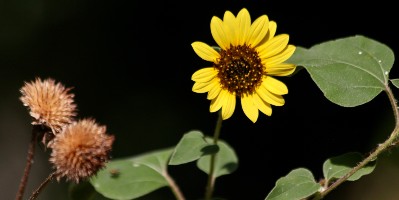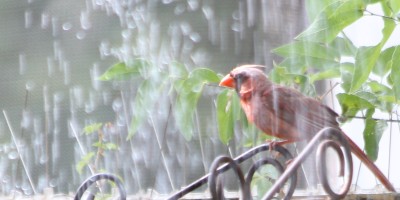THE HOTTEST JULY on record fried what was left of the black-eyed Susans, coneflowers, and blanket flowers in my garden, but I’ve been resisting the urge to cut back the plants because the spent flower heads still contain a few seeds to feed the birds.
And maybe I’m fooling myself, but I’m not hating the look of the wispy, beige, crunchy remains (see photo below). It’s not a look that’s likely to win me any neighborhood garden prizes — unless the prizes are given out by the birds. In which case I just might be a shoo in, because the birds are definitely liking the new wilder style of my home garden.
Since embarking on a mission to “rewild” my garden last fall, I’ve planted more native prairie grasses — Little Bluestem (Schizachyrium scoparium), Indiangrass (Sorghastrum nutans), Blue Gramma (Bouteloua gracilis), and Switchgrass (Panicum virgatum) — and more native seed-producers, including Blanket Flowers (Gaillardia); Prairie Coneflowers, aka Mexican Hats (Ratibida columnifera); and Common Sunflowers (Helianthus annuus).
I’ve been pulling overly aggressive weeds, in particular quack grass (Elymus repens) and three-lobe mallow (Malvastrum coromandelianum), but I’m experimenting with letting some other weeds stay as fillers between the prairie grasses and wildflowers that are growing in the sunny midsection of my backyard. And finally, I’m letting existing shrubs, vines, and trees grow and overlap as they wish to create a layered woodland effect around the perimeter of my property.
I’m thinking it might be this grassy/weedy meadow and woodland combo that brought a pair of painted buntings to my backyard this spring.
My new duplex neighbor, Kayla, spotted the pair early one morning in late April. She’s a master birder (lucky me to have such a neighbor!), so when she heard the male’s song she jumped out of bed and rushed out to the backyard with her binoculars. Then she texted me and I ran out to look.
The pair were perched, partially hidden, on a leafy pecan branch that was hanging above my old shed. I could just barely make out the bright colors of the male. But that was enough to confirm that they were there, and for me to know that I must be doing something right.
Since that morning, Kayla has been keeping a list of our increasingly diverse mix of avian residents and visitors.
Here’s the official list as of August 1: American Cardinal, American Crow, American Robin, Bewick’s Wren, Black-chinned Hummingbird, Black-crested Titmouse, Blue Jay, Carolina Chickadee, Carolina Wren, Great Crested Flycatcher, Great-tailed Grackle, House Finch, Lesser Goldfinch, Painted Bunting, Western Kingbird, White Wing Dove, and assorted migrating warblers (Yellow Warblers, Nashville Warblers and American Redstarts).
I still have much to discover and learn about how to use the principles of “rewilding” in a Central Texas home garden. But the way I see it, that’s a good thing. Following are some of the lessons I’ve learned so far:
During an impossibly hot summer, a stand of common sunflowers is a must have. While native salvias, cosmos, and even zinnias struggled to survive in July’s extreme heat, my sunflowers managed to keep blooming with just a little hand watering every week. And they’re still blooming.

If the birds, butterflies, and bees could vote, I’m sure they would all pick sunflowers as the stars of my summer garden.
_______________________________________________
Birdsongs are a good thing even when the singer isn’t a songbird. Western Kingbirds aren’t considered songbirds, but when they find a territory they like, they sing an exuberant dawn song every morning to defend their space. In late May, a Western Kingbird chose my garden as his territory. Every morning for a few weeks I woke up with a smile as I listened to his song.

Hot, thirsty birds cannot resist an oscillating sprinkler. Once or twice a week, I position a sprinkler so it waters one of my thirsty trees. Then I sit about 25 feet away, partially hidden by a big Flame Acanthus and watch, often with camera in hand, as the birds swoop in from all corners of the backyard. Chickadees and finches like to fly back and forth through the water spray on their way to nibble on sunflower seed heads.
A resident cardinal likes to get wet and then perch on a nearby trellis to preen himself (see photo). On a recent morning, more than a dozen birds attended the sprinkler party. I don’t leave the water on for long, maybe 10 or 15 minutes, but every minute spent watching this sprinkler-induced bird ballet is worth a few extra dollars on my water bill.
Some weeds are more desirable than others. I recently learned that pigweed (a wild amaranth) is a favorite food of painted buntings. Can I tolerate a patch of pigweed if it attracts painted buntings? Maybe. I left one pigweed standing the last time I weeded, and it is setting seed (see photo above).
Another common roadside weed that popped up this spring in my side yard, Texas Prairie Parsley (Polytaenia texana), definitely gets to stay. It attracts pollinators, isn’t too aggressive, and develops a deep tap root system that helps it survive drought cycles. And it’s not bad looking.
________________________________________________
Good gardens are better than bird feeders. The healthiest food support system for backyard birds is a diverse mix of plants, shrubs, and trees that produce seeds and berries and/or attract insects. If that kind of habitat isn’t possible, it’s fine to use a bird feeder, but feeders should be sanitized every two weeks to prevent the spread of diseases. Also, scientists studying birds have determined that a bird feeder doesn't increase the number or the variety of birds in a given space.
________________________________________________
More birds equal more bird poop. Bird poop is certainly not my favorite part of a wilder, bird-friendly garden, especially when it lands in big splats on my car’s windshield (sigh).
________________________________________________
More birds also equal more happiness. A growing body of scientific evidence suggests that nature — in particular interacting with birds — may be an important antidote to the doom and gloom feelings many of us are experiencing in response to the seemingly dystopian turn our world is taking.
A 2020 study from the German Center for Integrative Biodiversity found that people who live near natural areas with a greater diversity of bird species were demonstrably happier. Researchers determined that a 10 percent increase in bird species increased personal feelings of satisfaction as much as a comparable increase in income.
Another recent study at California Polytechnic State University found that hikers who could hear birds singing felt a greater sense of joy than those who heard no birdsong. The survey results showed that both the sounds themselves and people’s perception of biodiversity increased their feelings of well-being.
So even if next summer is just as bad or worse than this summer, I’m going to keep doing what I can to increase and maintain biodiversity in my little nature preserve in the middle of Austin. I guess you could say I’m doing it for the birds. ❦
Longtime Austin gardener Renee Studebaker is a retired newspaper journalist who is now a freelance writer and garden educator. (All photos by Renee)

